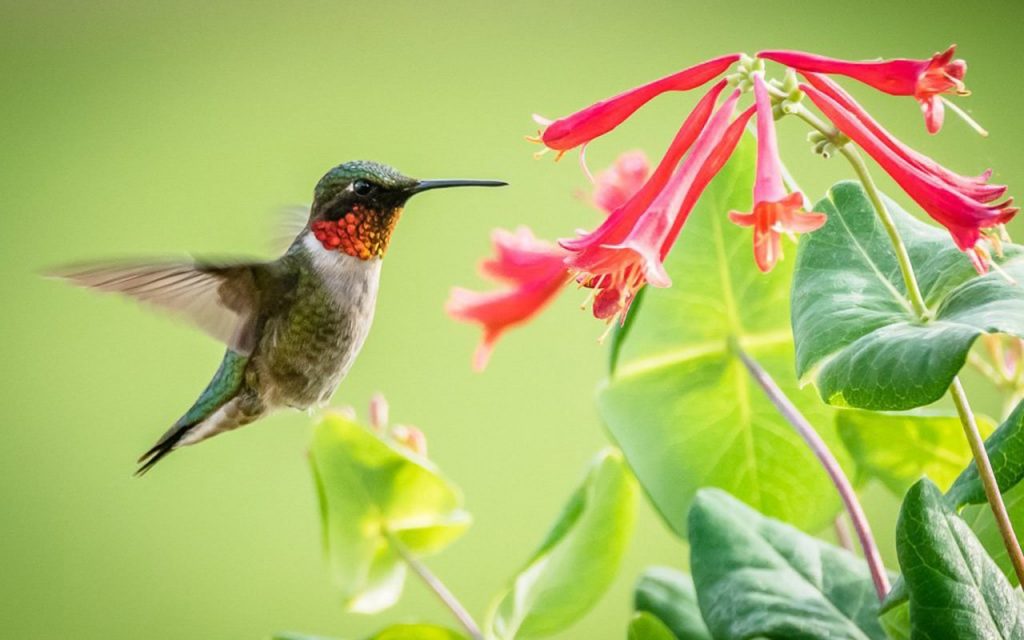Hummingbirds are the smallest species of birds on this planet, which is not the only record they hold. They are also the bird species that flap their wings the fastest, about 10 to 15 finds every second (that is one hell of a speed!).
They can flap their wings so quickly and powerfully that they can stay still in the air, just like a wasp or a butterfly. Apart from holding two records, Hummingbirds are also one of the prettiest and elegant birds that you would want to lay your eyes on. I mean, we have all watched them several times on documentaries and videos and deep down have that excitement about seeing them for real.
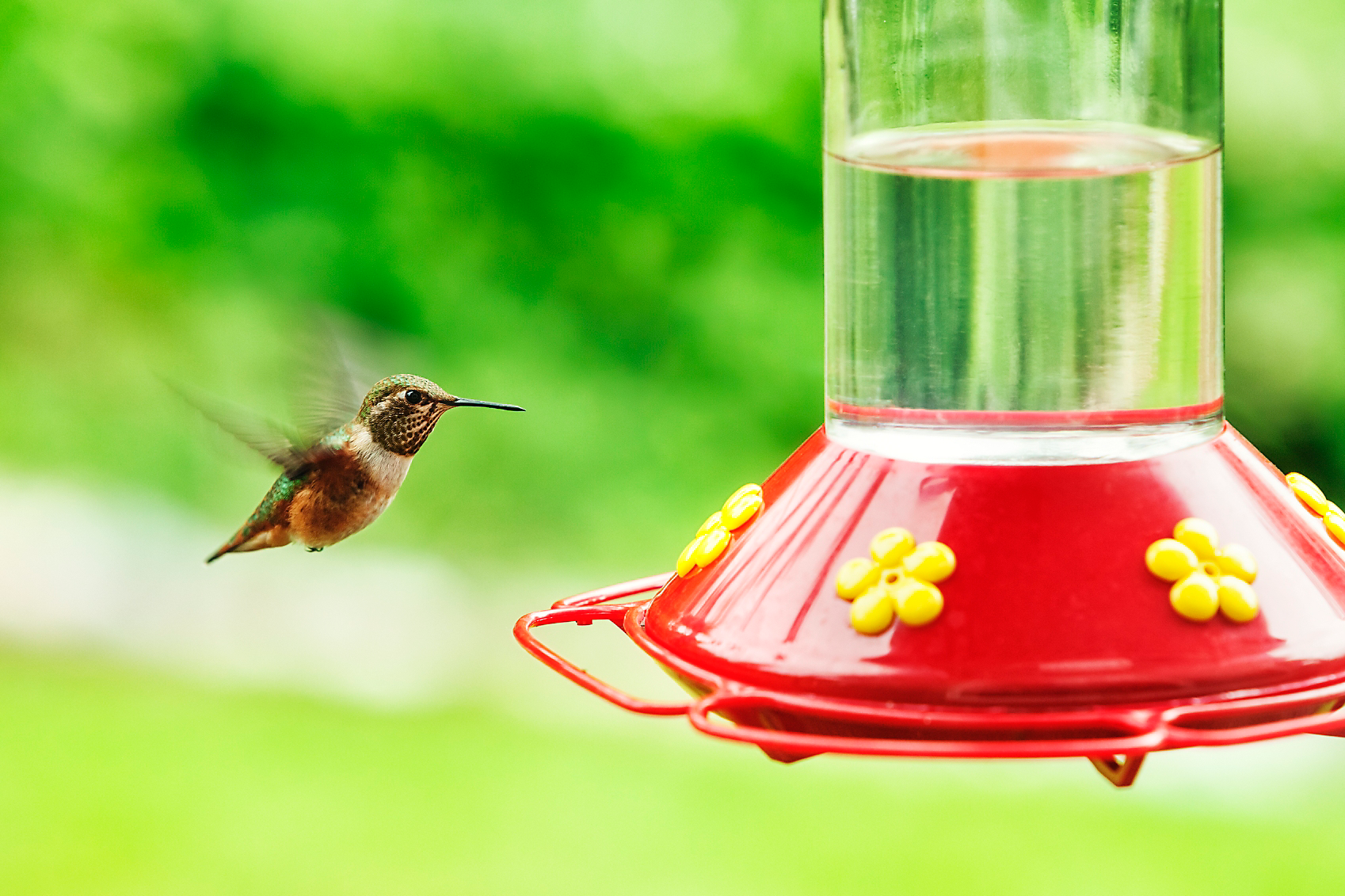
But watching them for real could only be done if you have something to offer them, something that can keep them busy while you are secretly admiring their majestic built. Hummingbirds happen to be one of the few birds that feed on nectar like other insects and butterflies, and by providing a good source of nectar to them, you can watch them.
These artificial nectars can be bought ready-made or prepared at home by mixing four water units for each unit of sugar. The water should be boiled and cooled down first. The device in which this nectar is stored for the hummingbirds is called a hummingbird feeder, and it can also be bought or made at home.
Having a hummingbird feeder filled with good nectar increases your chances of witnessing those cute little hummingbirds. However, there still is no guarantee, and you may need to optimize on certain aspects to make sure that the hummingbirds visit your nectar and then revisit it repeatedly.
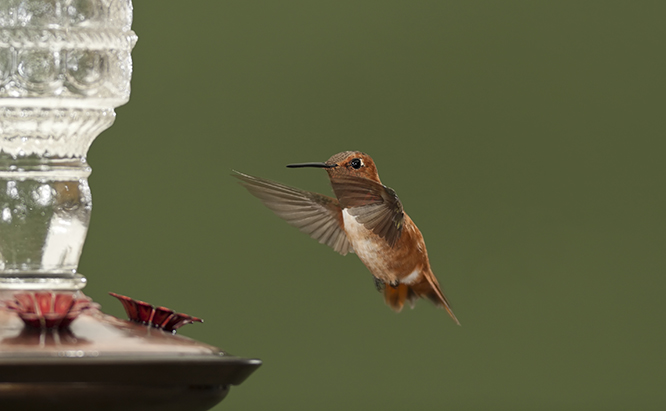
Even after getting the best hummingbird feeder and preparing the best nectar, many people discover that the hummingbirds are not visiting their feeder. The reason behind this phenomenon is not as straightforward as you think it is, as there are a lot of factors determining the traffic of hummingbirds towards your hummingbird feeder. Some of the reasons why hummingbirds are not coming to your house could be attributed to these issues.
Your Locality May Not Be Quiet Enough
If you live in a city or have a lot of children in your house, then or have a constant source of loud noise in your locality, then this might be the reason why hummingbirds are not visiting your nectar.
If there is a construction project in your neighborhood’s progress, then there are high chances that it will be a source of loud noise. Loud noise can easily scare the hummingbirds off as they are very tiny creatures and do not like to be around places with a loud noise.
Pollution in Your Area
Pollution also affects the traffic of hummingbirds. No living thing on earth benefits from pollution, and the higher the pollution, the higher are the threats to the health of these species. The smallest of the species have the worst immune system, and thus, they are the worst affected in case of pollution. Thus, hummingbirds will not come around your place if the pollution in your area is significantly high.
Poor Garden Maintenance
The influx of hummingbirds is also dependent on your garden. Your garden should be well hospitable for hummingbirds. Well, to make your garden hospitable for these little guests, plant more and more flowers and make sure that there is enough green cover in the garden. Because, like any other nectar-feeding insect, hummingbirds love the bloom and are directly attracted to it. Remove all the dead or spoilt plants as they might be a problem.
The Positioning of Your Hummingbird Feeder
Last of all, the placement of your hummingbird feeder is also a determinant of whether a hummingbird will visit or revisit your garden. There are so many places where you can place your hummingbird feeder, but there are only a few places that will give you the best results.
The best place to keep your hummingbird feeder to attract the hummingbird could be different for different people. The structure and type of garden and availability of space for every person are different.
Of all the above reasons, garden maintenance and your hummingbird feeder placement are the only two under your influence, and you can capitalize on both by taking appropriate action.
If you ignore these issues, there will not be any improvement in the number of hummingbirds visiting your garden, and you will be wasting your time and energy changing the nectar in the feeder and cleaning the feeder.
Why Does Placement of Hummingbird Feeder Matter?
As we discussed earlier, hummingbird feeder placement is one of the critical components for a successful hummingbird party in your garden. Failing to use this opportunity properly is also one of the key reasons you may not have hummingbirds visiting your garden.
Placing the hummingbird feeder under a canopy or a cover may prevent the hummingbirds from discovering it. This may also happen if the hummingbird is placed in deep foliage as it may hinder it from being seen.
Hummingbird feeder, when kept in the sun, can get spoilt due to fermentation. Hummingbirds kept in a very shady area may not provide you with the best view of the hummingbirds as the appropriate amount of light will not fall on its body.
Hummingbirds might fall prey to small animals like cats who can disturb their meal and make them leave your garden forever.
However, the hummingbird feeder’s right positioning ever will result in the nectar not fermenting quickly, the hummingbirds easily discovering your feeder, and none of them being disturbed by cats or other animals.
So, because hummingbird feeders’ placement is so crucial for welcoming these small birds inside your garden, we will pay keen attention to this problem and try to solve this once and for all so that you do not have to face any issues the future.
Improving the Placement of Your Hummingbird Feeder
By correctly altering your hummingbird feeder’s placement, you will be able to see a significant shift in the number of hummingbirds coming to your feeder. The position of the hummingbird feeder depends on a lot of factors, and you should consider each of these factors to make sure whether the place of your choosing is the best place for the hummingbirds or not and if not, then what should be done about it.
Hummingbird Feeder Regular Maintenance
Change the Nectar of Your Hummingbird Feeder Regularly
The nectar inside the feeder is the meal for hummingbirds, and you should make sure that you do not serve them with a stale meal. So always change the nectar of your feeder regularly. On a sunny day or generally in summers, change the liquid every two days as it ferments quickly in the summer, and the winter changes the liquid once a week. It would help if you changed the liquid even though no hummingbird has fed on it.
Check Your Hummingbird Feeder for Cracks or Leakages
Always check the hummingbird feeder for cracks and leakages once a week. A crack in the feeder may lead to liquid oozing out and make the whole surface messy. This regular check-up is even more necessary in the rainy season because of obvious reasons.
Wash and Clean the Feeder from Inside Out Regularly
The hummingbird feeder might get dirty on the outside due to a plethora of factors, and it is essential to clean it so that it attracts the most hummingbirds.
Factors Determining the Placement of Hummingbird Feeder
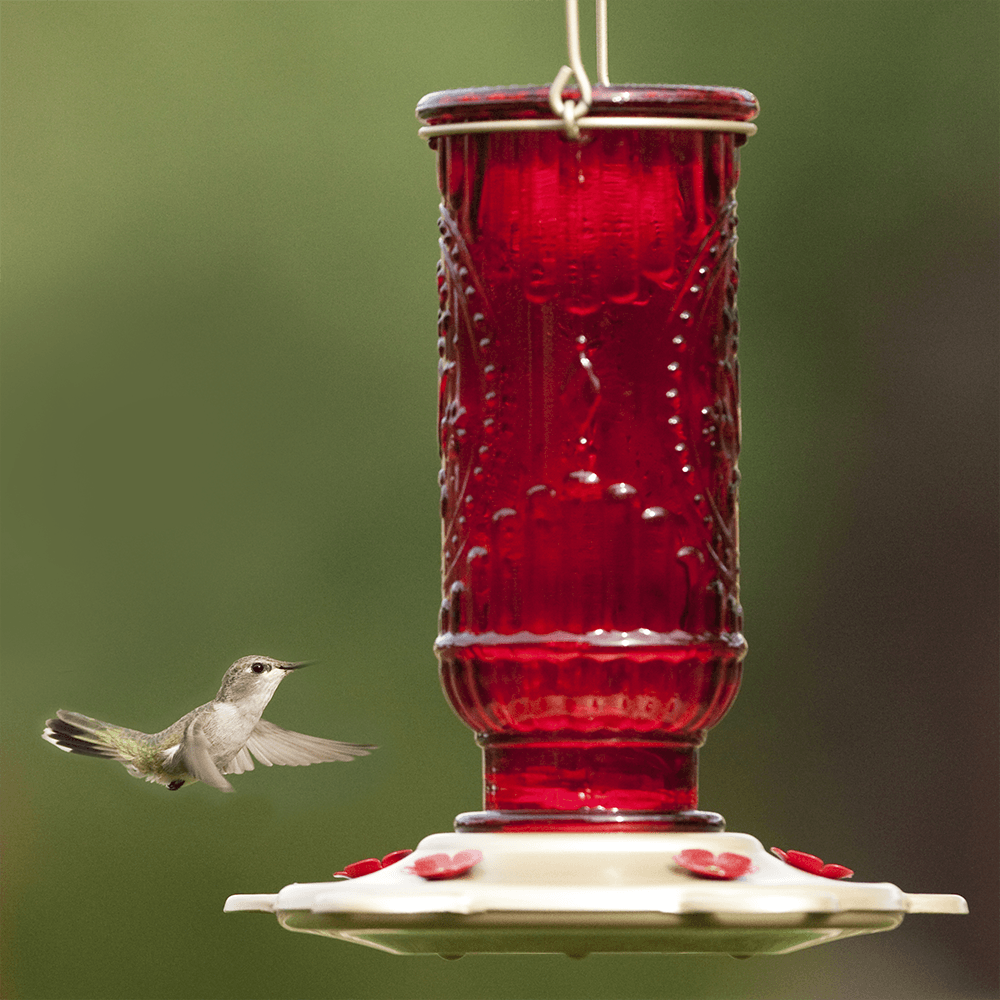
So now, let us know about the factors that determine the placement of hummingbird feeders.
Noticeable
A hummingbird feeder should be kept at a location from which it is easily noticeable by the hummingbirds. Placing the feeder under a deep roof or amid tree foliage might make it difficult to notice, and hence the hummingbirds may not even discover it.
It should be kept in an open space so that it is visible to the eyes. You can also use a feeder with a color that catches the eyes quickly. Try not to use feeders with green color as the feeder might camouflage in the environment.
Convenient
You can see a volcano from your bare eyes, but it is not at all convenient for you to go there. The same goes with the hummingbird feeder. It should be both easily noticeable and convenient to reach as there is no use in discovering the feeder if the birds are not going to feed the nectar.
Try to place the feeder near a cover or a tree so that the birds can rest there if need be. The feeder should also be kept at a place where you can easily reach it for regular maintenance.
Safe
Being the smallest bird of all birds, the hummingbird is very sensitive to any disturbance. Cats and other animals can be a significant threat for these little creatures, so you should always place your hummingbird feeder five or six feet above the ground so that it is way above the reach of these animals.
Also, make sure that there is no pole or plant beneath the feeder as the animals might climb to the feeder using them. Always keep a watch on which animals and birds are roaming around your feeder. If you find that it is not safe, change the position immediately.
Private
If you have a big garden or observe the increase in the number of hummingbirds visiting your garden, then you should consider getting extra feeders. This is because hummingbirds, despite being the cutest animals, do not like sharing and are very territorial.
So, to avoid any disturbance, try to provide more feeders to distribute the number of hummers. Also, do not keep these feeders next to each other or at places where the other one is readily available from the first feeder. You can either keep them on either side of the house.
Close
The purpose of planting hummingbird feeders is to feed the hummers and see them while doing so. So, to make sure that the last criteria are met, make sure that the feeder is placed near your eyesight, so you do not have to do too much hassle to get a glimpse of these creatures.
Ensure that you can see the feeder from your window, and you do not have to get out every time. If the feeder can be seen from the window, you can also keep an eye on any problem with the feeder, and this way, you will also be able to take the best photos if you want very quickly.
It is always advisable to keep a distance of at least 10 to 15 feet between the feeder and the window; otherwise, the hummingbird might collide. And if you do not want to keep it away from the window, then keep it right next to it so that the birds can see the window and avoid colliding.
Shade
The next thing you should consider while hummingbird feeder placement is the shade. Make sure that the place where you have kept it has appropriate sunlight and at the same time make sure that it gets proper shade.
Too much sunlight could amplify the fermentation process, and too much shade will also prevent you from getting a good view of the hummers. In the rainy season, keep the feeder under a canopy or a roof to not get spoilt. Analyze the sunlight and shade areas around your garden correctly and decide which place would be the best for you.
Well-Spaced
Hummingbirds need a whole lot of space to remain in the air. Therefore, make sure that there is enough space around the feeder for the hummingbird to fly. If it does not have enough space, the hummer might face difficulty, and the feeder may not allow more than one bird at a time.
While placing the feeder, make sure that the hummer can revolve around the feeder. Make sure that nothing is in the range of 10 to 15 feet of the feeder apart from the pole which holds it.
Best Places for Placing A Hummingbird Feeder
The best places for keeping the hummingbird feeder according to the above factors are-
- Patio or a hummingbird garden that is full of bloom and has the shade that the feeder requires.
- On or near the kitchen or office window. So that you can easily see the hummers and click photos and check the feeder for maintenance.
- Within 10 to 15 feet of a protective cover like a bush or a tree, the hummers can rest between eating and get small insects for consumption.
What Should You Hang A Hummingbird Feeder On?
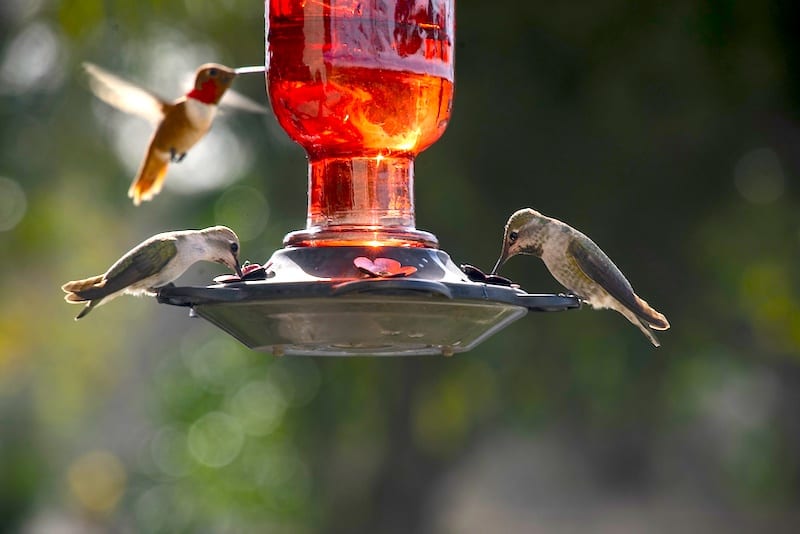
You can hand your hummingbird feeder on various things like a tree by tying a rope or hanging a hanger from one of its branches. The other alternative is using a pole that has a hanger attached. If you want to keep it near the window, then attach it to the window. You can also hang it from one of the roofs of your house or the canopy.
Conclusion
These are some factors that will help you decide on a location for your hummingbird feeder. Ensure the feeder takes proper care and replaces the nectar when it gets stale or fermented.
Also, save time to admire these small creatures’ beauty and think of the complications jam-packed in this bird, which is the size of your finger. Do not forget to capture this moment as you never know when they will return.
But if they start coming at a regular interval, they may start to recognize you and not be scared in your presence. This way, you can make them sit on your hand, and that is one hell of a feeling! But instead of being so ambitious in advance, let us first focus on welcoming the hummers and feed them the beat nectar.

